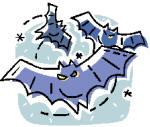 |
|||||||||||||||
|
|
|
|
|||||||||||||
|
GYPSIES AND VAMPIRES
by Beverley Richardson
Even today, Gypsies frequently feature in vampire fiction and film, no doubt influenced by Bram Stoker's book "Dracula" in which the Szgany gypsies served Dracula, carrying his boxes of earth and guarding him.
In reality, Gypsies originated as nomadic tribes in northern India, but got their name from the early belief that they came from Egypt. By 1000 AD they started spreading westward and settled in Turkey for a time, incorporating many Turkish words into their Romany language.
By the 14th century they were all through the Balkans and within two more centuries had spread all across Europe. Gypsies arrived in Romania a short time before Vlad Dracula was born in 1431.
Their religion is complex and varies between tribes, but they have a god called O Del, as well as the concept of Good and Evil forces and a strong relationship and loyalty to dead relatives. They believed the dead soul entered a world similar to ours except that there is no death. The soul stayed around the body and sometimes wanted to come back. The Gypsy myths of the living dead added to and enriched the vampire myths of Hungary, Romania, and Slavic lands.
The ancient home of the Gypsies, India has many mythical vampire figures. The Bhuta is the soul of a man who died an untimely death. It wandered around animating dead bodies at night and attacked the living like a ghoul. In northern India could be found the brahmaparusha, a vampire-like creature with a head encircled by intestines and a skull from which it drank blood.
The most famous Indian vampire is Kali who had fangs, wore a garland of corpses or skulls and had four arms. Her temples were near the cremation grounds. She and the goddess Durga battled the demon Raktabija who could reproduce himself from each drop of blood spilled. Kali drank all his blood so none was spilled, thereby winning the battle and killing Raktabija.
Sara or the Black Goddess is the form in which Kali survived among Gypsies. Gypsies have a belief that the three Marys from the New Testament went to France and baptised a Gypsy called Sara. They still hold a ceremony each May 24th in the French village where this is supposed to have occurred.
One Gypsy vampire was called a mullo (one who is dead). This vampire was believed to return and do malicious things and/or suck the blood of a person (usually a relative who had caused their death, or not properly observed the burial ceremonies, or who kept the deceased's possessions instead of destroying them as was proper.)
Female vampires could return, lead a normal life and even marry but would exhaust the husband. ghastly_tales_for_adults.htm who had a hideous appearance, was missing a finger, or had animal appendages, etc. was believed to be a vampire.
Even plants or dogs, cats, or farm animals could become vampires. Pumpkins or melons kept in the house too long would start to move, make noises or show blood.
To get rid of a vampire people would hire a dhampire (the son of a vampire and his widow) to detect the vampire. To ward off vampires, gypsies drove steel or iron needles into a corpse's heart and placed bits of steel in the mouth, over the eyes, ears and between the fingers at the time of burial. They also placed hawthorn in the corpse's sock or drove a hawthorn stake through the legs. Further measures included driving stakes into the grave, pouring boiling water over it, decapitating the corpse, or burning it.
In spite of the disruption of Gypsy lives by the various eastern European communist regimes, they still retain much of their culture. In 1992 a new king of the Gypsies was chosen in Bistritz, Romania.
SLAVIC VAMPIRES
ROMANIA
EIGHTEENTH CENTURY VAMPIRE CONTROVERSY
|
|||||||||||||||
|
|||||||||||||||

